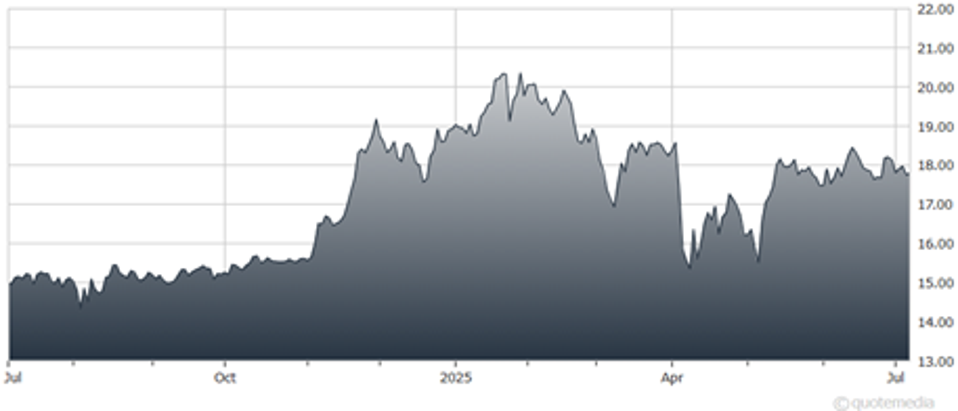So much for the Liberation Day selloff! Markets are rising to new highs – and our MoneyShow experts have several ideas on how you can capitalize. Here are three.
What about housing?
It’s a question I used to get a LOT. After all, I closely analyzed and wrote about the mortgage and real estate industries for years. But even though I haven’t heard it much from friends, family members, colleagues, readers, and conference attendees, I have heard a few people talk about housing STOCKS and ETFs as value/turnaround plays.
Which brings me to today’s pair of MoneyShow Charts of the Day. First up is the year-over-year change in the (yes it’s a mouthful!) S&P CoreLogic Case-Shiller US Home Price Index. You can see that after booming during Covid and the year or two afterward, house price appreciation collapsed. Then prices started falling.
Price growth resumed in late 2003, accelerated into 2024, but has been easing back ever since. That brings me to my next chart, which shows the SPDR S&P Homebuilders ETF (XHB).
The $1.5 billion ETF owns shares of 35 home builders, building products companies, home improvement retailers, and home furnishings firms. Sample names include PulteGroup Inc. (PHM), TopBuild Corp. (BLD), Lennox International Inc. (LII), and Toll Brothers Inc. (TOL). I used a weekly timeframe and am showing a half-decade of trading.
You can see that the XHB fared poorly in late-2023, rallied throughout 2024, then slid lower into April – just like the broad averages. But even as the lagging house price data hasn’t turned up, XHB held support at the 200-week simple moving average, then started rallying. It’s now challenging overhead resistance at the 50-week SMA. RSI is confirming the rebound.
I wouldn’t say housing stocks are out of the proverbial woods. But I’d watch this level, see if they can punch through that resistance, and if so? Maybe take a stab at XHB or related stocks as potential value plays.
Roger Conrad Conrad’s Utility Investor
Midstream energy stocks are a great way for income-seeking investors to get a piece of the AI boom and accelerating demand for electricity. And few, if any, are as well positioned as Energy Transfer LP (ET).
The diversified midstream company yields north of 7% and is raising its dividend on a quarterly basis at an annualized rate between 3% and 5%. That dividend is also a tax-advantaged return of capital.
Energy Transfer is coming off a solid Q1 in which its distributable cash flow covered its payout by better than a 2-to-1 margin and it covered capital spending with operating cash flow. Overall interstate natural gas transportation volumes hit a new record. Crude oil throughput expanded by 10%, NGL transportation 4%, NGLs/refined products 4%, NGL exports 5%, and midstream gathered volumes 2%.
That growth is being driven in large part by low-cost acquisitions over the past few years, and more recently by using the stock of its Sunoco LP (SUN) affiliate. Energy Transfer’s EBITDA from Sunoco grew by 89.3% in Q1. It will take another big jump when Sunoco closes the $9.1 billion acquisition of Canadian fuels distributor Parkland Fuels (PKIUF) in second half of 2025.
Energy Transfer is a player in the global LNG trade, with its Lake Charles LNG export facility almost fully contracted and set to start up later in the decade. But management is talking more and more about its opportunity to ship gas to data centers, especially in Texas.
The company has a long-term agreement to supply the CrowdBurst facilities in central Texas. It has also entered the generation business, building a fleet of eight 10 megawatt capacity natural gas-powered facilities in Texas.
Renewable energy — particularly solar plus storage — is currently Big Tech’s favored way to feed its electricity appetite. Facilities can be deployed at scale within 12 to 18 months of the planning stage. And the cost is a fraction of other sources, with or without tax credits.
When you build renewables at scale, however, you’ve got to have natural gas. And adding meaningful, new nuclear capacity is a decade away at best. That means Big Tech is going to need a lot more gas. And Energy Transfer is well positioned to transport it to them.
Earnings season continues to deliver surprises – both good and bad. But the market rewarded a telecom giant for another solid quarter while punishing one of the most well-known restaurant chains for falling short yet again. Verizon Communications Inc. (VZ) had a +2.69 reaction score after reporting a double beat.
It’s a reminder that even in a generally positive earnings backdrop, the reaction often depends more on sentiment and expectations than the raw numbers. VZ reported revenues of $34.5 billion, versus the expected $33.74 billion, and earnings per share of $1.22, versus the expected $1.19.
VZ has now been rewarded for three consecutive earnings reports, rallying 4% after this one. Here’s why:
- Q2 consolidated revenue reached $34.5 billion, up 5.2% year-over-year, driven by wireless service and equipment revenue growth.
- They surpassed 5 million Fixed Wireless Access subscribers and posted four consecutive quarters of core prepaid growth.
- Management also raised full-year guidance for adjusted EBITDA, adjusted EPS, and free cash flow.
Technically speaking, the stock is a hot mess. However, the fundamentals are trending in the right direction. With a dividend yield exceeding 6%, we believe this presents an attractive opportunity for income-seeking investors.
The price is in the process of resolving a massive bearish-to-bullish reversal pattern, and the VWAP anchored to the 2019 high is our line in the sand. If and when VZ reclaims $46, the path of least resistance will shift from sideways to higher.

